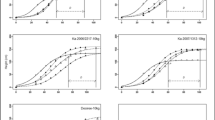Abstract
Excised roots of six potato selections were challenged with egg inoculum of fourMeloidogyne species:M. chitwoodi, M. javanica, M. incognita, andM. hapla. The dual cultures were established under aseptic conditions in 60 × 15 mm petri plates on a defined agar medium. Egg hatch occurred within one week and galling within four weeks at incubation temperature of 24°C. All six potato selections, Russet Burbank, White Rose, PAS 3065,S. sparsipilum 365343.A19-12,S. sparsipilum ×S. phureja 856D68-1, and NDTX8731-1R supported reproduction of all fourMdoidogyne species. Corresponding greenhouse tests were run with eachin vitro experiment to establish the efficacy of this screening technique compared to greenhouse methods. Results from the greenhouse assays had less variation within cultivar treatment than did the results from thein vitro assays. Thein vitro assay, however, may be conducted with less labor, time, and greenhouse facility management.
Compendio
Se expusieron raíces cortadas de seis selecciones de papa al inóculo (huevos) de cuatro especies deMeloidogyne: M. chitwoodi, M. javanica, M. incognita yM. hapla. Cultivos duales fueron establecidos bajo condiciones asépticas en platos de petri de 60 × 15 mm con un medio definido de agar. La eclosión de los huevos se produjo en una semana y la formación de agallas en cuatro semanas a una temperatura de incubación de 24°C. Las seis selecciones de papa, Russet Burbank, White Rose, PAS 3065,S. sparsipilum 365343.A19-12,S. sparsipilum ×S. phureja 856D68-1 y NDTX8731-1R permitieron la reproduction de las cuatro especies deMeloidogyne. Las pruebas correspondientes de invernadero fueron llevadas a cabo con cada experimentoin vitro para establecer la eficacia de esta técnica de evaluation y selectión en comparación con los métodos de invernadero. Los resultados de las pruebas en el invernadero variaron menos dentro del tratamiento de cultivares que los resultados obtenidos de las pruebasin vitro. Sin embargo, la pruebain vitro puede conducirse con menos trabajo, tiempo y manejo de las instalaciones de invernadero.
Similar content being viewed by others
Literature Cited
Bajaj, Y.P.S. and L.A. Dionne. 1968. The continuous culture of excised potato roots. N Z J Bot 6:386–394.
Barker, K.R. 1985. Nematode extraction and bioassays.In: Sasser, J.N. and C.C. Carter (Eds.). Advanced Treatise onMebidogyne. Vol. 1. Biology and Control. North Carolina State University, Raleigh, NC. pp. 19–35.
Canto-Saenz, M. 1985. The nature of resistance toMebidogyne incognita.In: Sasser, J.N. and C.C. Carter (Eds.). Advanced Treatise onMebidogyne. Vol. 1. Biology and Control. North Carolina State University, Raleigh, NC. pp. 225–231.
Chapman, H.W. 1956. Continuous growth of excised potato root tips. Am J Bot 43:468–471.
Dodds, J.H. 1988. Tissue culture technology: practical application of sophisticated methods. Am Potato J 65:167–179.
Dropkin, V.H., J.P. Helgeson and C.D. Upper. 1969. The hypersensitivity reaction of tomatoes resistant toMebidogyne incognita: reversal by cytokinins. J Nematol 1:55–61.
Fassuliotis, G. 1979. Plant breeding for root-knot resistance.In: Lamberti, F. and C.E. Taylor (Eds.). Root-knot Nematodes (Mebidogyne species). Academic Press, London, pp. 425–453.
Gomez, P.L., R.L. Plaisted and B.B. Brodie. 1983. Inheritance of the resistance toMebidogyne incognita, M. javanica, andM. arenaria in potatoes. Am Potato J 60:339–352.
Howard, H.W. 1970. Genetics of the potato. Springer-Verlag, New York. pp. 89–97.
Huettel, R.N. and R.V. Rebois. 1985. Culturing plant parasitic nematodes using root expiants.In: Zuckerman, B.M., W.F. Mai, and M.B. Harrison (Eds.). Plant Nematology Laboratory Manual. University of Massachusetts Agricultural Experiment Station, Amherst, MA. pp. 155–158.
Jatala, P. 1983. An efficient method for screening large numbers of potato seedlings for resistance toMebidogyne species.In: Hooker, W.J. (Ed.). Research for the Potato in the Year 2000. International Potato Center, Lima, Peru. pp. 105–106.
Murashige, T. and F. Skoog. 1962. A revised medium for rapid growth and bio assays with tobacco tissue cultures. Physiol Plant 15:473–497.
Orion, D., W.P. Wergin and B.Y. Endo. 1980. Inhibition of syncytia formation and root-knot nematode development on culture of excised tomato roots. J Nematol 12:196–203.
Orion, D. and M. Pilowsky. 1984. Excised root culture as a tool for testing root knot nematode resistance. Phytopathology 12:71–73.
Riggs, R.D. 1985. Making perineal patterns of root knot nematodes and vulval cones of cyst nematodes.In: Zuckerman, B.M., W.F. Mai and M.B. Harrison (Eds.). Plant Nematology Laboratory Manual. University of Massachusetts Agricultural Experiment Station, Amherst, MA. pp. 197–199.
Sawhney, R. and J.M. Webster. 1975. The role of plant growth hormones in determining the resistance of tomato plants to the root-knot nematode,Mebidogyne incognita. Nematologica 21:95–103.
S’Jacob, J.J. and J.V. Besooijen. 1971. A manual for practical work in nematology. International post-graduate nematology course. Wageningen. pp. 50–52.
Wambugu, F.M., G.A. Secor and N.C. Gudmestad. 1985. Eradication of potato virus Y and S from potato by chemotherapy of cultured axillary bud tips. Am Potato J 62:667–672.
Wang, P. and C. Hu. 1985. Potato tissue culture and its applications in agriculture.In: Li, P.H. (Ed.). Potato Physiology. Academic Press, Orlando, FL. pp. 503–577.
Author information
Authors and Affiliations
Additional information
Former graduate student
Rights and permissions
About this article
Cite this article
Rivera-Smith, C.E., Ferris, H. & Voss, R.E. The application of an excised root assay for the determination of susceptibility or resistance to root-knot nematodes (Meloidogyne spp. Goeldi) in potatoes (Solanum spp. L.). American Potato Journal 68, 133–142 (1991). https://doi.org/10.1007/BF02853894
Accepted:
Issue Date:
DOI: https://doi.org/10.1007/BF02853894



